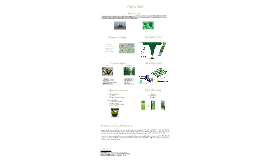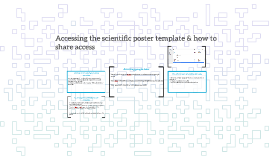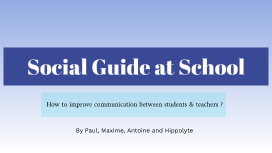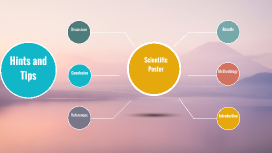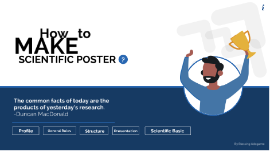scientific poster
Transcript: Scientific Poster Introduction Introduction An introduction outlines your investigation topic, question, background research, your aims and hypothesis What to include What to include What is your topic? Why you are undertaking the investigation? Relevant Background Information (referenced) Previous studies (referenced) Aim Hypothesis Tips Most information for this section should be recorded in your logbook Keep it as brief and concise as you can Include photographs (VCAA, n.d) to easily convey what your investigation is about (this can also cut down your word usage). Tips Methodology Your methodology should outline how you undertook your investigation, what equipment you used and the steps you took Methodology What to Include Outline the steps you took to undertake your investigation The materials you used with measurements if relevant The equipment you used Include health and safety issues and any ethical issues you faced What to Include Methodology Tips This information should be outlined in your logbook Include pictures and diagrams (this can cut down your word usage) You don't need to include smaller scale pilot studies on your poster but do include them in your logbook Keep it concise Give enough detail so that the investigation could be undertaken by someone else (VCAA, n.d) Tips Results The results section should outline the results that you found and be expressed in the appropriate format (VCAA, n.d). You also need to outline what your results show (Long & Elizer, 2009) but do not explain why in this section. Results What to include After you have analysed your data, choose a small number of graphs and figures that best represent your data. The graphs chosen should show trends (VCAA, n.d) You should briefly describe what is shown in each graph, including significant numbers but do not interpret the data (WHAT but not WHY) What to Include Tips Choose the graphs and figures that best represent your data Do not include graphs, figures or tables that show the same information (VCAA, n.d) room is precious and repeating information is unnecessary Remember to label your graphs axes Label your tables and figures Tips Discussion Discuss and interpret your findings Discussion What to Include Analyze your results-was this what you expected (refer to your hypothesis) why/why not? What have other studies found? What are possible explanations for your results? Were there limitations to your study? What? Why? How could you improve the study? What to Include Tips Be concise Reference all resources you use in the correct format Tips Conclusion Your conclusion will include a concluding statement that will state if your hypothesis was supported. You will also outline limitations and possible future research directions from your investigation. Conclusion What to include What to Include A concluding statement Was your hypothesis supported? What were the limitations of your study? -What parameters were not included in your investigation? For example seasonal differences, time of day fluctuations Where could you take your investigation in the future? References You need to include a section with acknowledgments and references. Acknowledgments Who helped you with your study? References A list of information sources you cited throughout your poster References Ask your teacher about the correct referencing style to use Hints and Tips Hints and Tips Be brief and concise-your word count is 600 words (VCAA, n.d). Think about how you set out your poster- it needs to flow logically (Alley, n.d). Can be electronic or hard copy (VCAA, n.d)- you can easily customise a PowerPoint slide (Click the design tab-slide size-custom slide size). Use appropriate colours, fonts and font size. Keep it simple (MakeSigns, 2019). An abstract is not necessary for a scientific poster (VCAA, n.d) but ensure this is the case with your teacher. Choose what you include wisely so that the poster is not crowded and confusing. Use visual aids. Pictures, diagrams and photos can help to keep your word count down. Reference all sources you have used, using an appropriate referencing method, check with your teacher about which method to use. Information for your introduction, methodology, results and some information for your discussion should already be in your logbook. Remember to draft your poster and show it to your teacher








